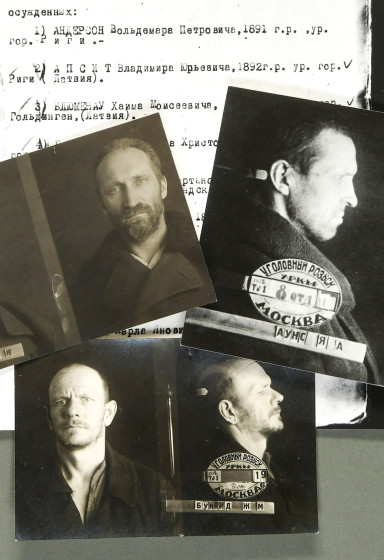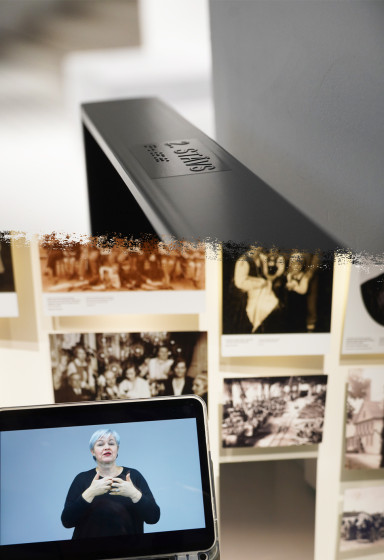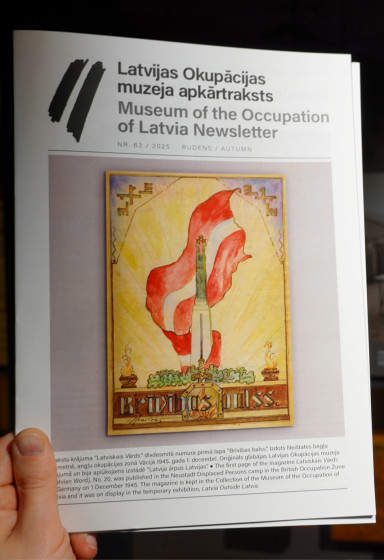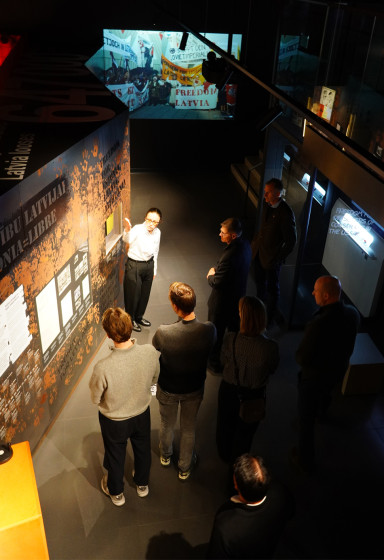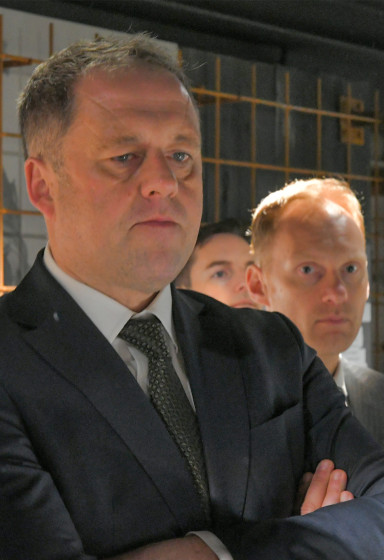Donate to Museum
Each donation helps to ensure the Museum's activities, allowing it to function and provide information for people from all over the world.
The Museum is grateful to each donor and invites everyone to contribute.
COMMENT ON VLADIMIR PUTIN’S DOCTRINE OF HISTORY

Photo: Design sketch for a new exposition at the Museum of Occupation titled "Conspiracy. The Hitler-Stalin Pact". Author – design bureau "H2E".
Valters Nollendorfs, the Chairman of the Board of the Association of the Museum of the Occupation of Latvia, has written an extensive commentary in response to Russian President Vladimir Putin’s article The Real Lessons of the 75th Anniversary of World War II, which was published in the American journal The National Interest on 18 June 2020.
V. Nollendorfs: “When the political leader of a neighbouring country writes about history, one should pay attention. Even more so if the historical message becomes a doctrine with contemporary implications. The article can be viewed as both Putin’s doctrine of history and as a didactic instruction. Its mission and objective is to glorify the no-longer-existing Soviet Union "that claimed an epic, crushing victory over Nazism and saved the entire world" and seeks to restore the post-war world order that "laid the foundation of a world that for 75 years had no global war, despite the sharpest contradictions." With such a lofty moral position, the doctrine bears the hallmarks of a religious creed.
The Putin doctrine rejects historical interpretations which make the Soviet Union, through the treaties it signed with Nazi Germany, as the main instigator of the war. According to the doctrine, the USSR was forced to conclude the Hitler–Stalin Pact for reasons of self-defence; the USSR was a reluctant party to the pact. The lion’s share of the blame for the war falls on the Western Allies and its chief victim, Poland. The Soviet Union was guided by noble motives; it suffered the greatest casualties of the war and deserves praise as the destroyer of Nazi Germany. Any other interpretation is an impermissible rewriting of history and an insult to the victims and heroes of the Soviet Union.
The Putin doctrine affects Latvia, Lithuania and Estonia very directly, not only in a historical but also in a contemporary context. It is directly related to Russia’s foreign policy orientation and its ambitions to restore its dominant position in the “sphere of interest” allocated to the USSR in the Hitler–Stalin Pact.
Only one brief paragraph in the doctrine is assigned to the Baltic countries and their fate in being caught between two great powers and in their subsequent war:
In autumn 1939, the Soviet Union, pursuing its strategic military and defensive goals, started the process of the incorporation of Latvia, Lithuania and Estonia. Their accession to the USSR was implemented on a contractual basis, with the consent of the elected authorities. This was in line with international and state law of that time. […] The Baltic republics within the USSR preserved their government bodies, language, and had representation in the higher state structures of the Soviet Union.
It is significant and perhaps surprising to read a statement, if not an admission, confirming that it was the Soviet Union which began the “incorporation process” of the Baltic countries, as this fully aligns with the secret protocols of the Hitler–Stalin pact and the events of the time. However, the Baltic countries have a different historical account of this process as well as facts to back it up. This evidence has been available to be read, seen and touched in the exposition and collection of the Museum of the Occupation of Latvia since 1993. It is currently on display in the Museum’s temporary home on Raiņa bulvāris in central Riga, and from next year it will be available at the reconstructed and expanded museum building on Strēlnieku laukums in Riga’s Old Town. How does the Putin doctrine appear in the light of the Museum’s exposition and materials? And what lessons should not be drawn from the doctrine?
The museum portrays the pact concluded between Hitler and Stalin on 23 August 1939 as a conspiracy by the two totalitarian powers to undermine the international order of the time, its conventions, laws and treaties. They may have been weak but nevertheless – they existed. For the conspirators, the Baltic countries and other states and nations in Eastern Europe were nothing more than objects to be traded to further the powers’ aims. The pact breached and unilaterally annulled all the treaties concluded by Latvia with both powers, including the peace treaty signed in August 1920 with Soviet Russia, which "forever renounces all sovereign rights held by Russia in relation to the Latvian nation and land."
The "process of incorporation on the basis of treaties" mentioned by Putin began immediately after the division of Poland and the signing of the German-Soviet Frontier and Friendship Treaty on 28 September 1939. Threatening military invasion, the USSR forced the Baltic countries to sign "mutual assistance pacts," which called for large Red Army units to be stationed within their borders. The seriousness of these threats was demonstrated by the Soviet attack on Finland, which had refused to sign such a pact. While the pact spared Latvia from war, it robbed it of a large degree of the sovereignty which Soviet Russia had agreed to respect "forever" in the 1920 peace treaty.
The most crucial step in “concluding treaties” came in June 1940. While Hitler’s Wehrmacht was conquering Western Europe, the USSR made preparations to achieve its military goals. The Baltic countries were encircled by large land forces and subjected to a naval blockade. The Soviets accused the Baltic States of breaching the mutual assistance pacts and threatening the security of the USSR. Latvia’s ambassador in Moscow was given a note demanding fulfilment of the pact within nine hours, including establishment of a new government and allowing a large Red Army contingent to enter Latvia. The government had no choice but to accede to the demands. The rest was left up to Soviet tanks, which crossed the frontier of Latvia on 17 June. This was OCCUPATION.
To ensure that everything went to plan, high-ranking emissaries were sent from Moscow to the Baltic countries. A puppet government sanctioned by Moscow was established in Latvia. It immediately set about dismantling the structures of the independent state and replacing them with a Soviet republic subordinate to the USSR. Soviet-style elections with a single list of candidates and compulsory voting were swiftly arranged. The Red Army provided security for the polls. The parliament thus elected voted unanimously to establish a Soviet republic and ask for admission to the USSR. The same process took place simultaneously in Estonia and Lithuania. It was ANNEXATION.
Only a handful of people believed that these events took place "in line with international and state law of that time." United States Acting Secretary of State Sumner Welles protested against them, declaring that "the people of the United States are opposed to predatory activities no matter whether they are carried on by the use of force or by the threat of force. They are likewise opposed to any form of intervention on the part of one State, however powerful, in the domestic concerns of any other sovereign state, however weak."
Many countries never recognized the annexation of Latvia. Until the restoration of independence in 1991, the Republic of Latvia may have been occupied and annexed, but it continued to be a subject under international law. The legal continuity of the Republic of Latvia is an important fact which the Russian Federation does not acknowledge. The state re-established on 21 August 1991 is not a new state – it is the internationally recognized continuation of the state founded on 18 November 1918. This was succinctly and clearly expressed by the foreign minister of Iceland, who two days later became the first to extend his congratulations on the re- establishment of the state of Latvia: "Iceland has never recognized the military occupation of Latvia and its illegal annexation by the Soviet Union."
Details about all the aforementioned events are available at the Museum of Occupation. The Museum sheds light on the direct and long-term consequences of the two Soviet occupations: the tyranny of the Latvian Communist Party subordinated to Moscow underpinned by secret police terror, deportations, repressions and a massive Soviet Army presence; the enforced Soviet colonisation policy which flooded the territory of Latvia with Russian-speaking immigrants, threatening to make Latvians a minority in their own country. It also holds many testimonies about why, contrary to Putin’s idealization of Latvia’s situation within the USSR, Latvians carried out prolonged armed and intellectual resistance to the occupation and why the Baltic nations led the way in the late 1980s in employing non-violent means to shake off the oppressive hegemony of the USSR and restore their independence.
At the end of the article, Putin turns to the post-war international order, attributing a key role in its establishment to the International Military Tribunal at Nuremberg and the United Nations, particularly the veto power held by the five permanent members of the Security Council, which Putin believes was the key to the 75 years of global peace which he wishes to continue.
Regarding the findings of the Nuremberg tribunal, Putin condemns the crimes of the Nazis, including the murder of the Jews in Latvia. However, his main focus is not on Nazi war criminals but on "all types of Nazi collaborators." He claims such collaborators could be found in all the countries of Europe and, "though they were disguised as fighters for national independence or freedom from communism – are traitors and slaughterers. In inhumanity, they often exceeded their masters":
[…] there can be no excuse for the criminal acts of Nazi collaborators, there is no statute of limitations for them. It is therefore bewildering that in certain countries those who are smirched with cooperation with the Nazis are suddenly equated with the Second World War veterans. I believe that it is unacceptable to equate liberators with occupants. And I can only regard the glorification of Nazi collaborators as a betrayal of the memory of our fathers and grandfathers.
With this, he builds a long bridge to the present. There is no doubt that Latvia is one of these "certain countries." There is little doubt that he is referring to the participation by some Latvians in the Holocaust and the unlawful conscription of Latvians into the Latvian Legion of the German Waffen SS. And it is clear that there is no room for national independence or freedom from communism in the moral world of the Putin doctrine. There is no room for the destruction of independent states by both Nazi Germany and the USSR, subjugation of their nations and manipulation of their people into becoming parties to their crimes.
The Museum of the Occupation of Latvia condemns the participation by Latvians in both Nazi and Soviet war crimes and crimes against humanity. But it also reiterates that the destruction of the state of Latvia "on the basis of treaties" left the citizens of Latvia at the mercy of both these powers. It documents the unlawful conscription of Latvian citizens into both the Red Army and the German forces, revealing how father was forced to fight against son and brother against brother in what was never Latvia’s war. At the same time, historical justice is important for Latvia, as is the commemoration of its soldiers who fought in two alien armies against two evils, keeping faith in Latvia’s freedom alive in their hearts. From the perspective of the state of Latvia, its nation and international law, all the “liberations” from 1940 onward were occupations.
It is regrettable that for all its moralistic pathos, the Putin doctrine has nothing to say about the crimes of the USSR and the devastation it inflicted on many nations in Eastern Europe. This is either left unmentioned or is attributed to a lone source of evil – Nazism. While mention is made of the massacre at Khatyn carried out by the Nazis in 1943, there is no mention of the much larger mass murder of Polish prisoners by Soviet secret services in almost eponymous Katyn in 1941, which was wrongly blamed on the Nazis for a long time. While the Nuremberg tribunal revealed Nazi war crimes and crimes against humanity, there has been no such inquest into Soviet crimes to date, and the Putin doctrine clearly indicates that there will not be one. Victors do not get investigated.
This leads to concern in all of Russia’s neighbouring countries harmed by the Hitler–Stalin Pact that the moral imperative set out in the Putin doctrine will be used to restore the post-war pax Sovietica, obviating all hope that Russia will ever recognize and restore historical justice. Although the Putin doctrine does not rescind the resolution adopted in 1989 by the Soviet Congress of People’s Deputies condemning the secret protocols to the Hitler–Stalin Pact and declaring them invalid from the moment of their signing, Putin’s historical doctrine unambiguously affirms that they are and will continue to govern Russia’s foreign policy.
The Museum of the Occupation of Latvia will not rewrite history as Soviet historians did and Russian historians and politicians still do today. It will continue to bear witness to the crimes against the state, nation and land of Latvia committed by both occupants; commemorate the victims of both occupying regimes and uphold national historical memory. Without a doctrine, in the name of justice and truth.
